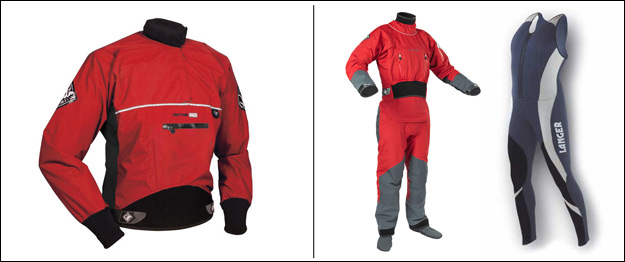
Warmeschutz - Derzeit nur in Englisch verfügbar
Bei der Teilnahme an einem Kurs benötigen Sie einen ausrichenen Schutzausrüstung bzw. Neopren / Trockenanzug.
In cold water you need thermal protection in order not to suffer hypothermia should you need to enter the water.
For most people going into cold water means donning the infamous wetsuit in order to stay warm. The neoprene insulates the body through its closed cell construction and has the advantage of being waterproof. Despite this fact if you go for a dip you will still end up being wet as water runs up your legs and down through the neck and zip (hence the name wetsuit). Just how much water comes through depends on the fit of the suit. If large amounts of water "flush" through the suit then it's not going to keep you much warmer than a paper bag. Most people think that they need a thicker suit when in fact they just need one that actually fits them. The more panels that your suit is made up of the better it will end up fitting to the contours of your body.
As soon as you get wet the environment will try to dry you and your clothing out using your body heat. This is why you shouldn't wear cotton in the outdoors as it takes a long time to dry out when it gets soaked. This will be worse if it is windy (the so called wind chill effect). This is bad news for us when we get wet. A outer shell that water runs off of is then much warmer than something that soaks up water. Neoprene which has a smooth outer is very effective at minimizing this heat loss. The bad news is that it is no good a standing up to the abuses of the river and river bank. So unless we want to buy a new wet suit every month we have to make due with a nylon outer layer which soaks up water and chills us when we are standing around on the bank. Anybody who says that a wetsuit needs to be wet to "work" is an idiot who should be thrown into the coldest river you can find at every opportunity.
In places where the water is cold and the environment is even colder drysuits are the best bet you have of not becoming hypothermic on the river. Be warned though their high cost and high maintenance requirements are not for everybody. Drysuits also offer protection from contaminated water, for most of your body, and are more comfortable to wear for extended periods of time if they have a "relief" zip fitted. However they do have some minus points: they have no padding so if you hit a rock it hurts more than if your wearing a wetsuit and it takes more effort to swim in as it crates more drag. You also need insulation under the suit best supplied with layers of fleece. The colder the water the more layers. A dry cag is the top half of the suit often used in combination with a wet suit by kayakers.
People will tell you that drysuits have no place on the river as if it gets a tear in it then you will sink to the bottom of the river and die. They are normally the same people who go on about wetsuits needing to be wet! It's complete rubbish as the only thing that will happen is that you will get cold and wet and very pissed off that your suit has a hole in it.